Blues 100 years ago: from America’s first female guitar hero!

My second last post (a great title for a mournful bugle solo, eh?), promised to tell you about the American guitarist, Helen Louise Ferera, who had a hit with ‘Palakiko Blues’, exactly a century ago, in 1917.
The track, a Hawaiian guitar duet with Helen Louise’s husband, Frank, is one of the earliest recordings of guitar – and slide guitar – with a blues title I know of. We might not recognise it as a blues today, but who are we to judge?
Back when Frank and Helen Louise cut the track, blues wasn’t the established art form it is now, and wouldn’t be until the blues divas of the 1920s popularised the structure laid down by W.C. Handy. Since the Fereras called ‘Palakiko Blues’ a blues, in all fairness, it was a pioneering blues back in 1917.
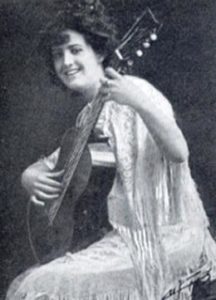
But wait, there’s more. In 1919, Helen Louise Ferera disappeared and was never seen again.
100 years ago, Frank and Helen Louise Ferera were massive vaudeville stars in the United States, touring widely and selling 78 rpm records by the truck-load around the world. Frank, a Hawaiian of Portuguese descent, was already a huge guitar star when he married a fellow guitarist, Helen Louise Greenus, an upper middle-class white girl from Seattle, Washington State.
Frank had been 30 and Helen Louise 29, when the couple released their first single, ‘On the Beach at Waikiki’ backed with ‘Moe Uhane Waltz’, in November, 1915.
Believe it or not
Earlier that year, Frank released two solo singles as a guitar star, and is said by many sources to have played to an estimated 17 million people in 1915 alone.
This amazing figure isn’t quite as unbelievable as first sounds. Frank was a guest steel guitar star with America’s leading Hawaiian band, Awai’s Royal Hawaiian Quartet, at San Francisco’s massively-popular 1915 Panama-Pacific Exposition. The Royal Quartet had a seven-month residency at the Expo, held to celebrate America’s successful construction of the Panama Canal. By my reckoning, that’s playing to about  33,330 people a day, which was the average attendance.
33,330 people a day, which was the average attendance.
(I gather that’s how they claim Frank played to 17 million, then. Some publicity guru reckoned everyone who attended the Expo heard him play with the orchestra. Maybe they did, maybe they didn’t.)
This huge Expo in San Francisco, together with the music of a wildly popular Broadway show in New York City, ‘Bird of Paradise’, caused an explosion of interest in Hawaiian music by America’s youth in 1915 and 1916. It was perhaps that era’s equivalent of rock ‘n’ roll or punk. Even crooner Bing Crosby (whom only the youngest of readers won’t have heard of) tapped into the craze, with a string of Hawaiian-theme themes.
Frank and Helen Louise Ferera were amongst the best-selling purveyors of Hawaiian-style music of the era, recording a stack of international best-sellers. Their ‘Drowsy Waters’ recording in 1916, for example, sold over 300,000 copies in the USA alone, when the average Hawaiian hit sold 15,000.
You could even call Frank and Helen the ultimate Hawaiian crossover artists since they performed the era’s latest hits, pop, jazz, ragtime and blues as well as regular Hawaiian music.
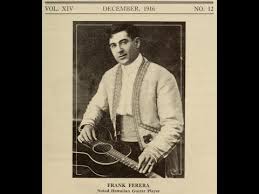
You may be wondering where the title ‘Palakiko Blues’ came from. Well, Palakiko was Frank’s real Christian name. In Hawaii, he had been Palakiko Ferreira. Indeed, the pair also performed and recorded as Helena and Palakiko, as well as under a variety of others names, including the Louise and Ferera Waikiki Orchestra and the Louise and Ferera Hawaiian Troup.
In 1916, the husband and wife recorded in New York City and, the following year, were joined by one of Helen’s three sisters, the ukulele and banjo playing vocalist, Irene Greenus. (Helen Louise’s maiden name was Greenus, as mentioned, and she and Irene had two more sisters back in Seattle.)
As a trio, Frank and Helen Louise Ferera and Irene Greenus released a host of popular discs over the next two years. Here’s one of their tracks, ‘Hawaiian Echoes’ from 1917. Frank would be playing steel guitar lead, but listen to the solid rhythm of Helen Louise and Irene Greenus on their guitars, banjos or ukeleles behind him. Malcolm Young would have been proud of them.
Helen Louise Ferera disappears
Between 1917 and 1919, Frank and Helen Louise spent at least a year in Hawaii. Perhaps they were taking a break because of Hawaiian music’s popularity being overshadowed by an outbreak of nationalistic American WW1 songs. Alternatively, as her father maintained, the couple travelled to the Pacific islands because of Helen Louise’s ailing health. This, incidentally, was the first time Frank had returned home to Hawaii since arriving in the United States in 1902 aged 17.
In 1919, Frank and Louise set sail from Honolulu bound for America and home. Naturally, they had the best accommodation, a stateroom cabin.
Late on a winter night, somewhere in the inky dark Pacific between Los Angeles and Seattle, Helen Louise took a stroll on deck. By 4am, she still hadn’t returned to the cabin, and Frank raised the alarm. The ship was searched thoroughly but the ship’s management reluctantly concluded Helen Louise was lost at sea.
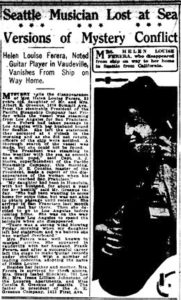
According to The Seattle Daily Times of 19 December 1919, writes Tim Gracyk at graccyk.com, “The 32-year-old daughter of Mr. and Mrs. Albert E. Greenus, of 1616 Summit Avenue (on the West slope of Capitol Hill, from the steamship President of the Pacific Steamship Company last Friday while the vessel was steaming from Los Angeles for San Francisco. Mrs. Ferera had taken passage in Los Angeles with her husband bound for Seattle. She left the stateroom they occupied at 4 o’clock in the morning and as she did not return, thorough search of the vessel was made, but she could not be found.’
“The ship’s captain reported that the ship was sailing in ‘fine weather with the sea as smooth as a mill pond.’ But her father reported to the newspaper, ‘There was a strong wind blowing Friday morning when my daughter left her stateroom and we believe she was washed overboard.’
“He also stated, ‘My daughter had been in Honolulu, with her husband, for about a year for her health. She had been wanting to come home for some time, but was not able to obtain passage until recently. She arrived in San Francisco last month and I met her there. Then she decided to go to Los Angeles to spend the holidays when she disappeared.’
Mr Greenus saying his daughter couldn’t obtain passage may refer to a shortage of ships traveling between Hawaii and the mainland during America’s fighting in World War I.
So did Helen Louise commit suicide because of her failing health? Was she pushed (not casting any aspersions here)? Was she washed overboard? We can never know. All we do know is that a passenger was swept overboard by waves, six years earlier, from a ship sailing fifty miles off Oregon’s Coos Bay. Two crewmen drowned, attempting a rescue, in heavy seas.

As for Frank Ferera, he teamed up with other partners from 1920 onwards, like Anthony Franchini and Dave Kaili and continued to be probably the biggest star of the Hawiian slide guitar. Frank also guested with the most popular orchestras of the day, like Paul Whiteman’s.
Getting back to the blues, in the mid-1920s, Frank Ferera recorded ‘St. Louise Blues’ as a solo artist and recorded duets with vocalist Al Bernard, known as the favourite male blues singer of the song’s composer, W.C. Handy. Although white, Al Bernard, was the first person in America to record ‘St. Louis Blues’ in 1917, following Ciro’s Club Coon Orchestra in London in 1916. There’s a post on this if you check my index.
Ferera and Bernard composed and recorded a number of songs in the 1920s including proto-country numbers like ‘De Ducks Done Got Me’. The pair also recorded the popular ‘It Ain’t Gonna Rain No Mo’, sung during the 1925 FA Cup Final by Sheffield United supporters, making it a popular British football song of the era.
But time catches up with most great music stars and, by the late 1920s, a new generation of steel guitarists swept into fashion, making Frank seem dated. He died in 1951.





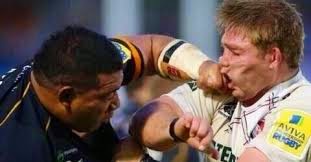
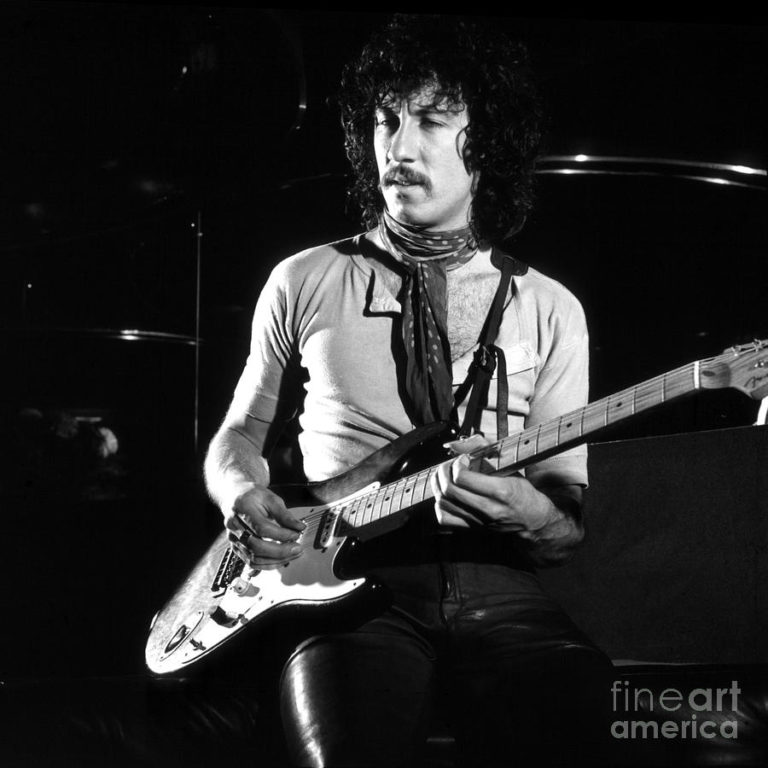
A really great article on a man who likely influenced many lap steel players of the swing, big band & Western swing era that grew during & after this period. It brings to mind early & influential lap steel players like Bob Dunn. Of course, pedal steels came into vogue after this, especially with hillbilly bands & Country groups.It’s interesting to see an early interplay of steel guitar & blues long before the rise of so many great slide players in the blues. Very sad & mysterious about his wife, I’m sure it was quite an item in it’s time. We do seem to forget so many women in music, especially ones like Sister Rosetta Tharp, Geeshie Wylie, Marie Evans, Miss Lavelle & Big Mama Thornton, the last two being on Duke/Peacock, 2 of Don Robey’s great Blues, Soul & Gospel labels. A most excellent article indeed!
Many thanks for your kind words, WRV11, and interesting comments. Talking of Bob Dunn, he’s featured in this video I made recently at https://www.youtube.com/watch?v=bnfuIcE4_7Q . Agree with you about the women in music and would like to give Memphis Minnie a mention as well … just so she’s not forgotten too.
You have remarked very interesting details! ps decent website. http://wikipaint.net/index.php?title=User:MozelleHylton9
Thanks very much for your feedback.
I love it when individuals come together and share thoughts.
Great site, keep it up! https://shapeon.org/
Thanks very much for your feedback, ShapeOn. Will try.
Howdy! This is my first visit to your blog!
We are a team of volunteers and starting a new initiative
in a community in the same niche. Your blog provided us beneficial information to work
on. You have done a wonderful job! https://prachecream.org/
Glad to be of help, guys. Thanks for your feedback.
Thanks for the article. I was wondering about Helen’s steel guitar playing. Rockwell’s Hawaiian discography lists her as playing steel guitar only on three unissued solo recordings for Columbia on 8/6/15, but as playing guitar (or banjo) to Ferera’s steel guitar on all other recordings. Do you have any information about this? Or is it a case of a woman couldn’t possibly play piano like Louise Johnson?
Many thanks for the feedback, Mark, and your interest. Let me try and answer your query. Helen must have played a regular acoustic guitar before her death in 1919. This is because the metal National Resonator guitar was only introduced in 1927, specifically because regular acoustic guitars could not be heard over Hawaiian bands. That was well after 1915, of course. The inventor, John Dopyera, then broke away from National in 1928 to manufacture the rival Dobro metal resonator guitar. The name stands for Dopyera Brothers. The first electric lap steel was introduced by Rickenbacker in 1932, so I’m not exactly sure what Rockwell’s discography means when it talks about steel guitars being around in 1915.
Thanks for the reply! Sorry for a misunderstanding! Actually, I was using the term ‘steel guitar’ in the sense of ‘Hawaiian guitar’ or ‘slide guitar’ (as does Rockwell), not the material the guitar was made of. So I guess my question is, was Louise just fretting while Frank was sliding? Sorry for the confusion. (Good to run across your site! And thanks for the history refresher.)
No problem, Mark. I’m afraid your question will have to remain unanswered, as I’d only be guessing if I said Louise was just fretting.